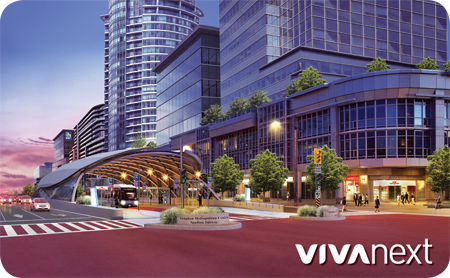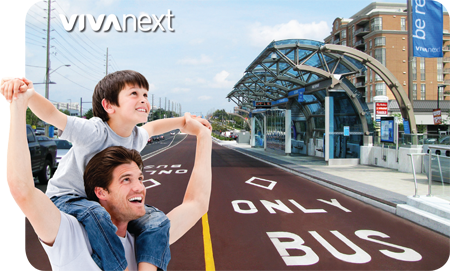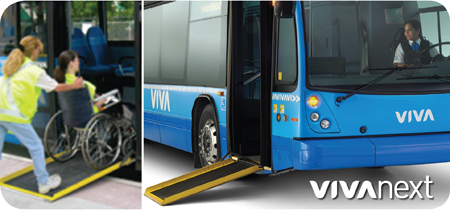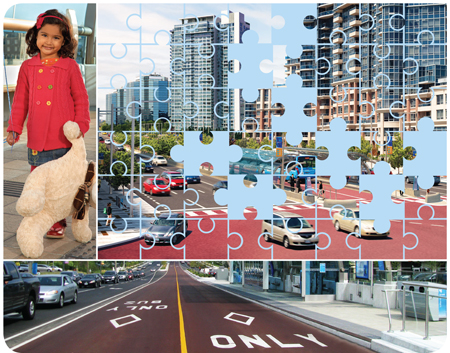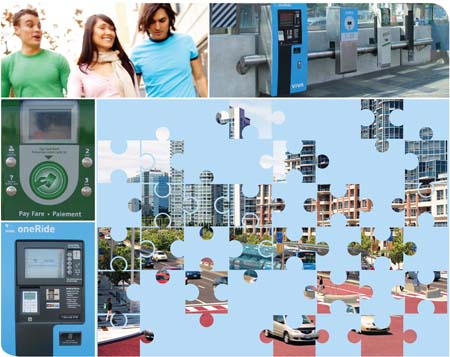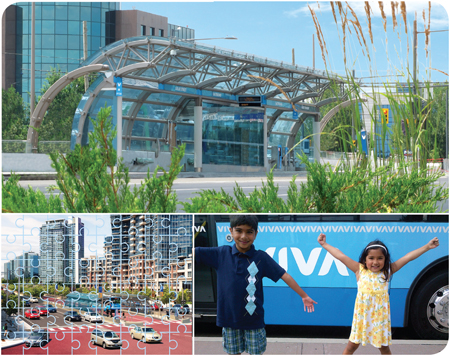
Rapidways are now open on Highway 7 and they’re beautiful, they’re functional, and they’re going to make a huge contribution to the transformation of our communities. Anyone travelling along Highway 7 in Richmond Hill or Markham has seen them from the outside, but here’s a peek of what they’re like on the inside.
The first thing you’ll notice as you cross to a station is how big and airy the canopy is at 28m (92’) long and 5m (16’) high. The curved glass above the platform also provides both weather protection and a sense of space at the same time and satisfies long-term needs as platforms accommodate two viva vehicles at once and LRT (Light Rail Transit) in the future. The platform is approached by a gently sloped ramp with handrails on both sides, making it fully accessible to all, whether they’re walking, pushing a stroller, or in a wheelchair or scooter. Passing by the familiar viva fin and planted planter boxes, you’ll next come to an illuminated wall map of the YRT\Viva system.
Next on the tour is a bank of fare equipment, including a Ticket Vending Machine (TVM), a Ticket Validator (TV), and two Presto machines. Once you’ve paid your fare, you’ll move to the Fare Paid Zone (FPZ), which is clearly shown by being paved with a different coloured tile on the ground, as well as by a curved sign above. We need to show this area as distinct, as YRT fare rules require passengers to have paid their fare before moving into the FPZ.
Once you’ve paid your fare, you’re free to make yourself comfortable on the platform until the next bus arrives. We’re making it easy for you to know how long you’ve got to wait, with a large VMS (Variable Message Sign) projected from the canopy. The VMS scrolls through all the upcoming arrivals, telling you exactly when the next bus will arrive. Because the VMS system is connected to the GPS in our actual vehicles as well as the central transit scheduling software, it can be constantly updated to provide accurate and real-time information.
But if you decide you want to sit down on a bench, or get comfy out of the elements, we’ve made that easy too. The fully heated glass enclosure is well lit, and accessed by two push-button automatic doors. The heaters – which won’t be needed anytime soon, but you’ll like them come later this year, they’re like the infrared heaters in a hockey arena – will automatically turn on if someone enters the enclosure, and if the temperature in the enclosure feels lower than 10 degrees Celsius. Multiple benches and garbage disposal units will add to your comfort.
The entire platform will be well lit, with lighting inside the canopy as well as on the platform. And to enhance your feelings of comfort and security, the back of the platform is protected from the Highway 7 traffic by a barrier wall topped with a guardrail, and there are multiple security features including cameras and an emergency call button.
Last but not least, to help you stay oriented, wayfinding signage will show you where the buses will stop, and other features including the way to the crosswalk.
It’s hard to do the stations justice by written descriptions, so we have created a virtual tour to entice you to come out and try viva.


